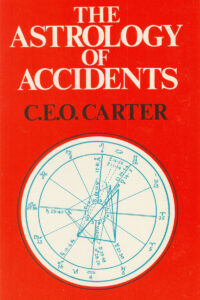The Astrology Of Accidents – Investigations and Research
By C.E.O. Carter.
123 Pages | First published in 1932, reprinted in 1978 | Softcover | Theosophical Publishing House, London | ISBN: 722950594.
One of the most important areas in looking at a horoscope is interpreting from the aspects indications of possible accidents; and the subject is made all the more difficult by defining what constitutes an accident. The author defines it as 'a bodily mishap occasioned without intent either on the part of the sufferer or the agent (if any) inflicting it'. There are various gradations of accidents, and in the research for this book, one of the primary considerations was to discover if possible any factors that are common to all serious accidents. Here with the evidence of statistics are 168 cases from Britain and the United States, which will assist astrologers in examining charts.
From the 'Preliminary Considerations' (p. 17):
" Our first investigations must be directed to discover, it possible, any factors that are common to all serious accidents, or at least occur more frequently than mere probability would explain. My total collection, at the time of 'closing the lists' for tables, comprised 168 cases. These may be roughly divided as follows: asphyxiation (5), drowning (14), burns (19), scalds (9), gunshots (4), blows (21), crushings (9), wounds and cuts (7), vehicular (22), falls (32), machinery (5), railway (3), poisons (1), explosions (4), miscellaneous (10) and animals (3). Some of this book was written before all of these had come to hand, hence the above figures may not exactly agree with others given in Part Two, which also contains cases that came in after the tables had been finished. "
C.E.O. Carter (1887 - 1968) was the most outstanding British astrologer of the 20th century. After the death of Alan Leo, Carter ran Leo's Astrological Lodge at the Theosophical Society, from 1920 to the 1952. He was first Principal of the Faculty of Astrological Studies, which he helped found in 1948. He edited The Astrologer's Quarterly from 1926 until 1959. Carter's books, penetrating & full of unique insights, are ideal for intermediate & advanced astrologers. They are, in fact, virtually in a class by themselves. Instead of a book on synastry, or forecasting, or horary or elections, Carter's books are organic wholes. Instead of treating aspects in one chapter, signs in another, and planets in a third, Carter shows how individual astrological factors combine to create living, breathing people. For example, Carter tells us that a cardinal grand cross has one sort of effect if it falls in succedent houses, quite another if it falls angular. It is this constant interplay of factors, and Carter's brilliant, lucid exposition, that makes his books so precious.
 Bezig met bijwerken...
Bezig met bijwerken...